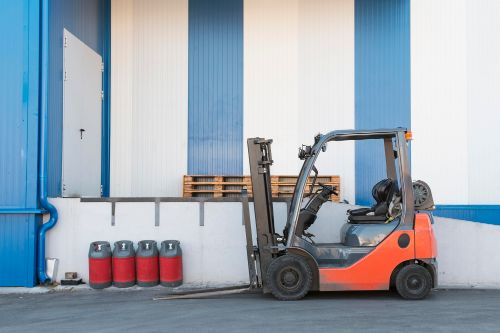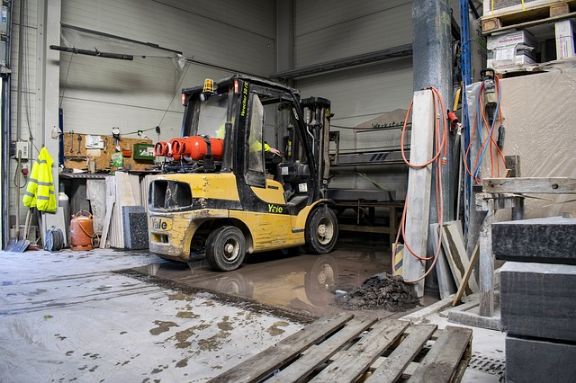
If you’re involved in the operation or maintenance of forklifts, understanding the role and types of propane solenoid valves is crucial. These components may seem small, but they play a pivotal role in the safe and efficient operation of propane-powered forklifts.
A propane solenoid valve is essentially the gatekeeper of fuel flow in a forklift. It controls when and how much propane passes from the storage tank to the engine. The efficient functioning of these valves ensures that your forklift operates smoothly, maintains proper fuel efficiency, and most importantly, stays safe for the operator.
In this article, we’ll delve into the different types of forklift propane solenoid valves. You’ll discover how each type functions and where it’s best applied. This knowledge is not just technical jargon; it’s practical information that can help you make informed decisions, whether you’re selecting a valve for a new forklift, troubleshooting, or performing routine maintenance.
Understanding these valves in-depth can also aid in improving the longevity and performance of your equipment. With the right valve in place, you can minimize downtime, reduce maintenance costs, and enhance overall safety. So, let’s get started on this journey to better understand the heart of your forklift’s propane system.
Understanding Propane Solenoid Valves
When you’re dealing with propane-powered forklifts, one of the key components you need to be familiar with is the propane solenoid valve. Let’s break down what this is, its role in forklifts, and how it works.
What Is This: This valve is an electromechanically operated valve specifically designed for regulating the flow of propane gas. When you hear ‘solenoid,’ think of it as an electronic switch that can be turned on or off by an electrical signal. This valve is integral in controlling the propane that powers your forklift.
The Role of This in Forklifts In a forklift, the valve is essentially the gatekeeper of fuel flow. It’s responsible for controlling when propane is allowed to flow from the tank to the engine. This control is crucial because it directly impacts the efficiency, performance, and safety of the forklift. A properly functioning valve ensures that the forklift operates smoothly, without interruptions or hazards related to fuel flow.
Basic Working Mechanism To understand how these valves work, imagine a simple on-off switch, but instead of controlling a light bulb, it controls the flow of propane. When the forklift’s ignition is turned on, an electrical current activates the valve. This current moves a plunger or lever inside the valve, opening a passage for propane to flow. When the ignition is off, or if there’s a need to stop the flow of propane, the current is cut off, causing the valve to close and stop the flow of gas.
Understanding this mechanism is key for troubleshooting. If your forklift isn’t starting or isn’t receiving fuel, the valve is one of the first components you should check. Ensure it’s receiving the correct electrical signal and that the valve itself isn’t stuck or damaged.
Remember, a well-maintained valve is essential for the smooth operation of your forklift. Regular checks and timely maintenance can save you from unexpected downtime and potential safety hazards.
Read related article: Replacing Service Valves on Forklift Propane Tanks: Short Guide
Types of Forklift Propane Solenoid Valves
When selecting a solenoid valve for your forklift, it’s important to understand the different types available, each with its unique characteristics and applications. Let’s dive into the most common types: Direct-Acting, Pilot-Operated, Two-Way, and Three-Way Solenoid Valves.
Direct-Acting
- Description and Working Principle: Direct-acting valves operate directly by the electromagnetic force. When energized, the solenoid directly lifts the plunger or diaphragm to open the valve, allowing propane to flow.
- Pros and Cons:
- Pros: Reliable, can operate without fluid pressure, and is effective for small flow rates.
- Cons: Limited in the size of the orifice they can open, which restricts their flow capacity.
- Typical Applications in Forklifts: Ideal for smaller forklifts where lower flow rates are sufficient, and reliability is key.
Pilot-Operated
- Description and Working Principle: These valves use line pressure to assist in operating the valve. A diaphragm or piston is opened or closed by the solenoid, allowing line pressure to open the main valve.
- Pros and Cons:
- Pros: Capable of controlling larger flows with smaller units, more energy-efficient.
- Cons: Require a minimum operating pressure to function correctly, not ideal for low-pressure applications.
- Typical Applications in Forklifts: Best suited for larger forklifts that require higher flow rates and have consistent operating pressure.
Two-Way
- Description and How They Differ: Two-way solenoid valves have two ports and can either allow flow or block it. They are simple on/off devices.
- Advantages for Forklift Use: Simplicity and reliability. They are perfect for basic on/off control of the propane flow, making them suitable for many standard forklift applications.
Three-Way
- Explanation of Their Unique Features: These valves have three ports and can be used to alternately apply pressure to and exhaust pressure from a valve actuator or a single-acting cylinder.
- Applications in Forklift Operations: Useful in forklifts that require more complex control systems, such as those with multiple fuel sources or advanced emission control systems.
Each of these valve types has its place in forklift operations. Your choice should be guided by the specific needs of your forklift, considering factors such as size, flow rate requirements, and the complexity of the control system. By selecting the appropriate type of propane solenoid valve, you ensure optimal performance and safety for your forklift operations.
Read related article: Forklift Propane Tank Orientation: Do These for Universal Tank
Factors to Consider When Choosing a Propane Solenoid Valve for Forklifts
Selecting the right propane valve for your forklift is not just about picking any valve off the shelf. Several key factors need to be considered to ensure that you choose a valve that not only fits but also performs efficiently and reliably. Here’s what you should keep in mind:
Compatibility with the Forklift Model
- Model-Specific Requirements: Each forklift model may have specific requirements for solenoid valves. Make sure the valve you choose is compatible with your forklift’s model and make. This includes fitting the physical dimensions, connection types, and electrical specifications.
- OEM Recommendations: Often, the forklift’s manufacturer will provide recommendations or specifications for replacement parts, including these valves. Following these recommendations can ensure compatibility and performance.
Pressure and Flow Requirements
- Understanding Your Forklift’s Needs: Different forklifts have varying pressure and flow requirements based on their size and engine type. It’s crucial to select a valve that can handle the required pressure and offers adequate flow for efficient operation.
- Avoiding Mismatches: A valve that doesn’t meet the pressure and flow requirements can lead to poor performance, increased fuel consumption, or even damage to the engine.
Environmental Factors
- Temperature and Exposure: Consider the typical operating environment of your forklift. Extreme temperatures, moisture, dust, and other elements can affect the performance and lifespan of a solenoid valve. Look for valves rated for the specific conditions they will encounter.
- Materials and Design: Certain materials and designs are better suited for harsh environments. For instance, valves with protective coatings or constructed from corrosion-resistant materials are ideal for challenging conditions.
Maintenance and Durability Considerations
- Ease of Maintenance: Choose a valve that is easy to access and maintain. This can reduce downtime and maintenance costs in the long run.
- Durability and Lifespan: Look for valves known for their durability and long lifespan. While they might be more expensive upfront, they can offer greater reliability and reduce the frequency of replacements.
Remember, the valve is a critical component of your forklift’s fuel system. A well-chosen valve will not only ensure smooth operation but also contribute to the safety and longevity of your equipment. Take the time to assess these factors thoroughly to make an informed decision that aligns with your operational needs and budget.
Installation and Maintenance of Propane Solenoid Valves in Forklifts
Proper installation and regular maintenance of the valves are vital for the efficient and safe operation of your forklift. Here’s a guide to help you with these processes.
Basic Steps for Installation
- Preparation:
- Ensure the forklift is turned off and the propane tank is disconnected.
- Gather the necessary tools and the correct replacement valve.
- Accessing the Valve:
- Locate the valve, typically near the propane tank or in the fuel line.
- Remove any components obstructing access to the valve.
- Removing the Old Valve:
- Carefully disconnect the electrical connections and fuel lines.
- Unscrew and remove the old valve.
- Installing the New Valve:
- Position the new valve and secure it in place.
- Reconnect the fuel lines and electrical connections, ensuring a snug fit without over-tightening.
- Testing:
- Reconnect the propane tank and turn on the forklift.
- Check for leaks and proper operation of the valve.
Routine Maintenance Tips
- Regular Inspections: Periodically check the valve for signs of wear, corrosion, or damage.
- Cleaning: Keep the valve and surrounding area clean to prevent debris from interfering with its operation.
- Leak Checks: Regularly test for leaks in the valve and the connections using a soap solution or a gas leak detector.
- Electrical Connections: Ensure the electrical connections remain secure and free from corrosion.
Common Issues and Troubleshooting
- Valve Not Opening:
- Check the electrical connections and ensure the coil is receiving power.
- Inspect the valve for physical blockages or damage.
- Valve Not Closing:
- Look for debris or corrosion that might prevent the valve from sealing properly.
- Test the coil with a multimeter to ensure it’s functioning correctly.
- Leaks:
- Tighten connections if they are loose.
- Replace worn or damaged seals or gaskets.
- Erratic Operation:
- Check for voltage fluctuations that could affect the valve’s operation.
- Ensure the valve is suitable for the pressure and temperature conditions of your forklift.
Remember, while some maintenance and troubleshooting can be done on your own, don’t hesitate to consult a professional if you’re unsure or if the issue persists. Regular care and prompt attention to issues will prolong the life of your propane solenoid valve and ensure the safe operation of your forklift.
Safety Considerations
When dealing with propane and electrical components in forklifts, prioritizing safety is not just a good practice; it’s essential. Propane is a highly flammable gas, and electrical components, if not handled correctly, can pose serious risks. Here’s some advice on how to stay safe.
Importance of Safety with Propane and Electrical Components
- Respect the Risks: Always remember that propane can be explosive under certain conditions, and electrical mishandling can lead to shocks or sparks, which in turn can ignite the propane.
- Stay Informed: Make sure you’re well-informed about the specific hazards associated with propane and the electrical systems of your forklift.
Safety Features of Different Types of Valves
- Direct-Acting and Pilot-Operated Valves: These usually come with built-in safety features like automatic shut-off in case of power loss, ensuring that propane doesn’t flow unchecked.
- Two-Way and Three-Way Valves: Look for models with additional safety features like manual overrides or explosion-proof enclosures, especially if your forklift operates in a high-risk environment.
Best Practices for Operators and Maintenance Staff
- Regular Training: Ensure that all operators and maintenance staff undergo regular training on the safe handling of propane and electrical systems. This should include emergency response procedures.
- Routine Checks: Incorporate routine safety checks before operating the forklift. This includes inspecting propane tanks, hoses, valves, and electrical connections.
- Proper Tools and Equipment: Always use the right tools and safety equipment. This means no shortcuts. Using the wrong tool for a job can be a safety hazard.
- Good Ventilation: When working on forklifts indoors, ensure there is adequate ventilation to prevent the buildup of propane gas in case of a leak.
- Emergency Protocols: Familiarize yourself with emergency protocols. Know where fire extinguishers are and how to use them. Also, understand the procedures for reporting and responding to gas leaks or electrical issues.
- Professional Assistance: If you’re unsure about a repair or maintenance task, don’t hesitate to seek professional help. It’s better to be safe than sorry, especially when dealing with complex or potentially hazardous systems.
Remember, safety in the workplace is everyone’s responsibility. By following these guidelines, you can help ensure a safer working environment for yourself and your colleagues.
Conclusion
the importance of choosing the right type of propane solenoid valve for your forklift cannot be overstated. This choice is much more than a technical decision; it’s a commitment to operational efficiency, safety, and reliability.
Each type of solenoid valve – whether it’s direct-acting, pilot-operated, two-way, or three-way – serves a specific function and fits certain operational requirements. The right valve ensures that the propane fuel is delivered to the forklift’s engine in the most efficient way, optimizing performance and minimizing fuel wastage. This efficiency translates into cost savings and a reduction in downtime due to fuel-related issues.
But beyond efficiency, the choice of valve has a significant impact on safety. Given that propane is a flammable fuel, and solenoid valves are integral to controlling its flow, selecting the appropriate valve is crucial for preventing leaks and potential hazards. A well-chosen and properly maintained valve is a key component in safeguarding against accidents and ensuring the well-being of operators and maintenance staff.
In closing, when you’re selecting, installing, and maintaining the valves, think of it as nurturing the heart of your forklift’s fuel system. Your attention to detail, commitment to safety, and dedication to regular maintenance don’t just extend the life of your forklift; they also create a safer and more efficient working environment. Remember, in the world of material handling and warehouse operations, the right small components can make a big difference.

Mike is an experienced propane technician with over 15 years of professional experience in the field. He has dedicated his career to helping customers with their propane needs, from installation to maintenance and repair. Together with Jeremy, he co-founded this website to provide useful information and guidance to customers seeking reliable propane services.



